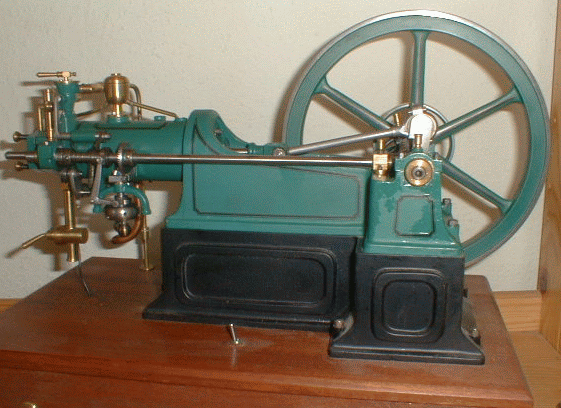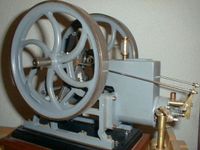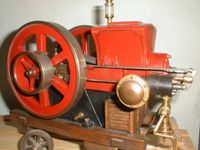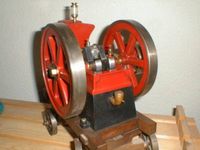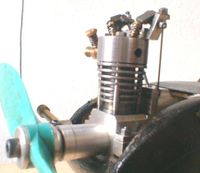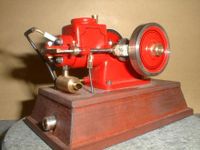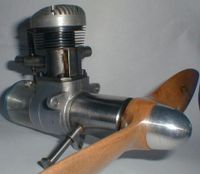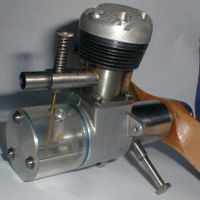Archive - interesting memories
All my engines and machines that are no longer offered on my homepage or have never appeared there will go into the archive. As far as I still have documents about single pieces, experimental engines or formerly offered model engines, I will gradually publish them here in different forms and descriptions ...
"Odilia Gasmotor"
Water-cooled 2-cylinder four-stroke engine
The engine was intended for a 5" light railway locomotive. Unfortunately, the locomotive was never finished due to lack of time. Model flying was and still is more important to me. I prefer to spend the little time I have at the model aerodrome. I already spend enough time in the workshop during the week.
First test run (it has stayed that way until now)
Technical data:
Stroke: 45mm
Bore 31mm
Otto's new four-stroke engine from 1876
This model engine is the first engine built in series by Nikolaus August Otto, which also became known as "Otto's new four-stroke engine".
This engine was offered in various sizes. There was a two, four, six and eight hp engine.
This model is the eight hp version on a scale of 1:10. Although it is very difficult to reconcile attention to detail with functionality in functional model making, I have managed to fulfil this requirement here. On the other hand, building the model also places high demands on the modeller.
Technical data :
Bore: 22 mm
stroke: 40 mm
Overall height: - - mm
Overall length: 380 mm
Overall width: 160 mm
Flywheel diameter: 200 mm
Weight: approx. - - kg
Atkinson
James Atkinson built and patented the engine in 1886. He did not design this engine because he wanted to change the world, but because N.A. Otto already had pretty much all the patents on four-stroke engines. The special feature of this four-stroke engine is that the intake and exhaust cams are mounted directly on the crankshaft and not on a separate camshaft with a 1:2 reduction ratio, as is usually the case with a four-stroke engine. The fact that the engine actually runs in four-stroke mode is achieved by a rocker arm and the main connecting rod, which engages with the crankshaft. Because fuel consumption was already a major consideration at the time, Mr Atkinson arranged the pivot points so that the engine had four strokes of different lengths. In relation to the exhaust stroke 1 (the longest stroke), the intake stroke is 1/3, the compression stroke ¼ and the working stroke 2/3, allowing him to utilise the expansion better.
Technical description:
Water-cooled four-stroke engine. The model is not a scale reduction because the technology would otherwise be installed in an almost closed box. However, the outer contours correspond to the original. The engine can run on gas or petrol.
Technical data:
Bore : 29 mm
stroke: 44, 19, 11, 37 mm
Overall height: 195 mm
Overall length: - - mm
Overall width: - - mm
Flywheel diameter: 197 mm
Simplex Vaporiser
This engine is based on the design of the Simplex four-stroke engine. The Simplex evaporator has two flywheels, which results in smoother running and also benefits the external appearance. The cylinder is fitted with a moulded and water-flushed liner. This model engine can be operated with petrol or gas.
Technical data:
Bore: 31 mm
Stroke: 50 mm
Overall height: 180 mm
Overall length: 315 mm
Flywheel diameter: 176 mm
Weight: approx. 12 kg
Here I have dug up another picture of my "Ursimplex"
VT-0,7 D
This 0.7 cc four-stroke diesel is currently the smallest engine I have on offer.
However, the 0.7D delivers a lot more power than you might think at first. My old Kadett from Graupner is sufficiently motorised with this engine and achieves record-breaking flight times even with economical fuel dosing...
Technical data:
Displacement: 0.7 cc
Bore: 10mm
Stroke: 9mm
Speed: 9500 rpm with 7 "x 5" prop.
Compression adjustment via eccentrically mounted crankshaft
Fuel consumption: 10 ml / 15 min.
The Smallest Hit & Miss motor ?????
A small stationary motor with hit & miss controller.
The engine is constructed from cast aluminium parts.
The engine is fuelled with lighter fluid and is complete with transistor ignition and integrated tank in the engine bed
Technical data:
Displacement 0,86ccm
Bore: 10mm
Stroke: 11mm
Flywheel diameter: 38mm
Cooling: Water
ignition: High voltage
Fuel: Lighter petrol
Liner: Steel, hardened and ground
Piston: GG, ground and lapped
Kratmo 10D Repl.
The Kratmo model diesel engine was produced with different cubic capacity sizes. The model engines with 0.3 cc, 0.6 cc, 1.25 cc and 2.5 cc were only built in small numbers due to the high demands on accuracy, and experimental engines with 5 cc, 7.5 cc and 10 cc were also built at the time, but were not manufactured.
The Kratmo 10D does not require the usual counter-piston. Compression is adjusted by the eccentrically mounted crankshaft.
